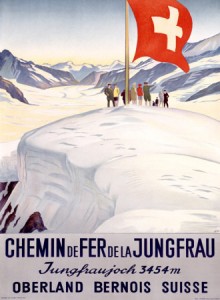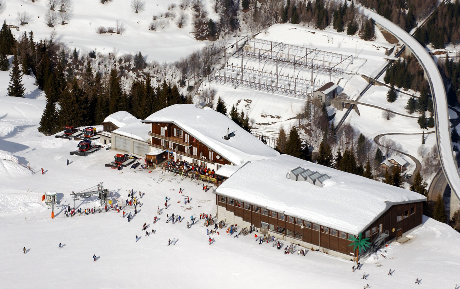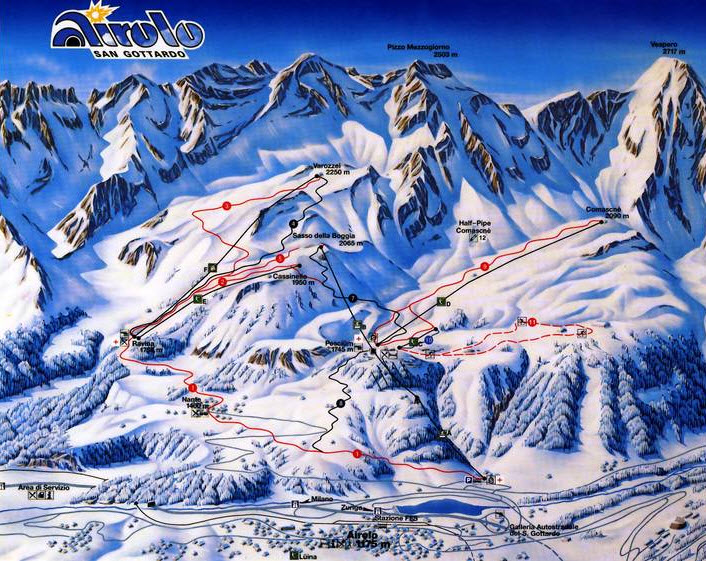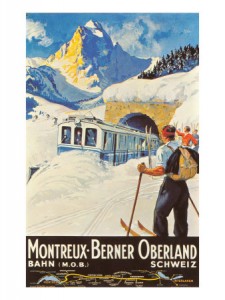 Tourism in Switzerland stretches back to the early 19th century, when the once forbidding mountains of the Alps became seen as embodiments of a natural order and attracted literary figures from Europe and the Americas. Byron, Shelley, Dickens, Conan Doyle, Twain and many others found beauty and majesty in the landscape, and after them came those who would conquer the mountains, enjoy the summer scenery or recuperate in one of the Alpine spa towns. One enterprising St Moritz hotelier wagered some English summer tourists that they would enjoy the winter too, and they did, and sparked an increasing interest in winter tourism amongst the well heeled English middle classes. In adapting Nordic ski techniques, organizing competitions and convincing the railway companies to keep their cog railways running through the winter months, the English laid the foundations of the modern winter sports industry, although the Swiss also proved to be enterprising and extremely capable hosts. Davos, St Moritz, Arosa, Leysin, Adelboden and the Jungfrau region were by the turn of the twentieth century well-established destinations for winter tourists.
Tourism in Switzerland stretches back to the early 19th century, when the once forbidding mountains of the Alps became seen as embodiments of a natural order and attracted literary figures from Europe and the Americas. Byron, Shelley, Dickens, Conan Doyle, Twain and many others found beauty and majesty in the landscape, and after them came those who would conquer the mountains, enjoy the summer scenery or recuperate in one of the Alpine spa towns. One enterprising St Moritz hotelier wagered some English summer tourists that they would enjoy the winter too, and they did, and sparked an increasing interest in winter tourism amongst the well heeled English middle classes. In adapting Nordic ski techniques, organizing competitions and convincing the railway companies to keep their cog railways running through the winter months, the English laid the foundations of the modern winter sports industry, although the Swiss also proved to be enterprising and extremely capable hosts. Davos, St Moritz, Arosa, Leysin, Adelboden and the Jungfrau region were by the turn of the twentieth century well-established destinations for winter tourists.
Switzerland has the longest established and one of the most successful winter tourism industries in the world. It is also meticulously documented, and in July the review of the 2009 year in tourism, “Schweizer Tourismus in Zahlen”, was published by the STV, Switzerland’s Tourism Federation.
Tourism accounts for around 5% of Swiss export revenue, around 15 billion Swiss Francs in 2009. During the 2008-9 winter season, of a total 15.8 million overnight stays in the country, roughly 6.9 million were by Swiss, 2.8 million were by Germans, 1 million by people from the UK, 0.7m by French and half a million each by Americans, Dutch and Italians. Belgians, Russians and Nordics also spend more than a quarter of a million nights in the country.
Although overall more visitors come to Switzerland in the summer than the winter, the British come more in the winter. The most popular destinations throughout the year were (in order of number of overnight stays in hotels):
- Zurich (11871 beds)
- Geneva (10230 beds)
- Zermatt (6040 beds)
- Lucerne (5577 beds)
- Basel (5662 beds)
- Davos (5334 beds)
- St. Moritz (4196 beds)
- Lausanne (3869 beds)
- Bern (3516 beds)
- Interlaken (3084 beds)
- Lugano (2889 beds)
- Grindelwald (2949 beds)
- Arosa (2867 beds)
It is indicative of how important the tourist industry is that Zermatt attracts more visitors than Basel, a major international centre for exhibitions and the pharmaceutical industry, and Davos and St Moritz more than the capital, Bern.
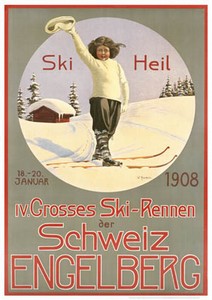 The destinations which achieved the Families Welcome designation for 2009–2012 were: Diemtigtal, Haslital with Hasliberg and Meiringen, Lenk Simmental, Arosa, Brigels, Davos Klosters, Flims, Laax, Falera, Trin, Sagogn, Lenzerheide, Maloja, Savognin, Schwarzsee, Braunwald-Klausenpass, Toggenburg, Triesenberg Malbun Steg, Villars with Gryon, Bex, Aletsch Arena with Bettmeralp, Fiesch, Eggishorn and Riederalp Mörel, Bellwald, Crans-Montana, Grächen, Leukerbad, Nendaz, Saas-Fee/Saastal and Engelberg-Titlis.
The destinations which achieved the Families Welcome designation for 2009–2012 were: Diemtigtal, Haslital with Hasliberg and Meiringen, Lenk Simmental, Arosa, Brigels, Davos Klosters, Flims, Laax, Falera, Trin, Sagogn, Lenzerheide, Maloja, Savognin, Schwarzsee, Braunwald-Klausenpass, Toggenburg, Triesenberg Malbun Steg, Villars with Gryon, Bex, Aletsch Arena with Bettmeralp, Fiesch, Eggishorn and Riederalp Mörel, Bellwald, Crans-Montana, Grächen, Leukerbad, Nendaz, Saas-Fee/Saastal and Engelberg-Titlis.
The corresponding award for wellness resorts went to Bad Zurzach, Charmey, Scuol, Gstaad Saanenland , Leukerbad, Baden, and Weggis Vitznau Rigi.
The proportion of pistes with snow-making in 2008-9 made up over a third of the total, a trebling in only 5 years and a demonstration of how much the Swiss are increasingly investing in their winter sports infrastructure. Total skier days for the season numbered almost 35 million.
Around 180 Swiss ski and snowboard schools provided over 2 million lessons over the course of the season, Graubünden and Valais making up roughly two thirds of this number.

